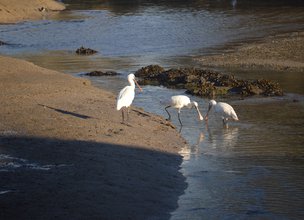Wetland with high ecological importance and essential conservation.
Veiga de S. Simão is a wetland located on the left bank of the Lima River estuary, occupying about 700 hectares along the parishes of Darque, Mazarefes, Subportela and Vila Franca.
In ecological terms, this is one of the most important wetlands in the municipality, with complex systems of reeds, salt marshes and reeds that, together with the Lagoons of Vila Franca, require specific and pertinent conservation measures and attention.
These places serve as a place to feed and shelter several species of shorebirds and waterfowl, namely wintering and migrating species.
In drier areas, out of the reach of marine waters, agricultural spaces and forests are spread out over 200 hectares.
In this area, there has been an important human interaction over time, which has allowed the existence of an agricultural space drained and traversed by several channels, transforming salty land into arable areas of high fertility. In this way, the drainage system limited the progression of marine waters inland, and the land closer to the river still works today as protection for the more inland land.
This ecosystem has undergone changes that constitute threats to biodiversity and habitat conservation, namely due to the proliferation of invasive species and human pressure.
In this place, inserted in the Lima River SCZ, the habitats contained in the Habitats Directive occur:
- 1140 - Mudflats and sands uncovered at low tide
- 1130 - Estuaries
- 1330 - Atlantic salty meadows (Galuco-Puccianellietalia maritimae)
- 1310 - Pioneer vegetation of Salicornia and other annual species in muddy and sandy areas
- 1320 - Meadows of Spartina (Spartinion maritimae)
- 1420 - Mediterranean and thermo-Atlantic halophytes (Sarcocornetea fruticosi)
- 91E0* - Alluvial florets of Alnus glutinosa and Fraxinus excelsior (Alno-Padion, Alnion incanae, Salicion albae) - priority habitat.
Veiga de S. Simão is a wetland located on the left bank of the Lima River estuary, occupying about 700 hectares along the parishes of Darque, Mazarefes, Subportela and Vila Franca.
In ecological terms, this is one of the most important wetlands in the municipality, with complex systems of reeds, salt marshes and reeds that, together with the Lagoons of Vila Franca, require specific and pertinent conservation measures and attention.
These places serve as a place to feed and shelter several species of shorebirds and waterfowl, namely wintering and migrating species.
In drier areas, out of the reach of marine waters, agricultural spaces and forests are spread out over 200 hectares.
In this area, there has been an important human interaction over time, which has allowed the existence of an agricultural space drained and traversed by several channels, transforming salty land into arable areas of high fertility. In this way, the drainage system limited the progression of marine waters inland, and the land closer to the river still works today as protection for the more inland land.
This ecosystem has undergone changes that constitute threats to biodiversity and habitat conservation, namely due to the proliferation of invasive species and human pressure.
In this place, inserted in the Lima River SCZ, the habitats contained in the Habitats Directive occur:
- 1140 - Mudflats and sands uncovered at low tide
- 1130 - Estuaries
- 1330 - Atlantic salty meadows (Galuco-Puccianellietalia maritimae)
- 1310 - Pioneer vegetation of Salicornia and other annual species in muddy and sandy areas
- 1320 - Meadows of Spartina (Spartinion maritimae)
- 1420 - Mediterranean and thermo-Atlantic halophytes (Sarcocornetea fruticosi)
- 91E0* - Alluvial florets of Alnus glutinosa and Fraxinus excelsior (Alno-Padion, Alnion incanae, Salicion albae) - priority habitat.
Location
Veiga de S. Simão is located on the left bank of the Lima River estuary and extends along the parishes of Darque, Mazarefes, Subportela and Vila Franca.
Coordinates
Lat: 41.690444
Long: -8.770583
Hello little one!
I'm Piquinhos and I can help you learn more about the Geopark!
Biodiversity
Biodiversity
In Veiga de S. Simão, natural meadows and reeds occur, dominated by Juncus sp., Bolboschoenus maritimus and Phragmites australis, aggregated tábua (Typha latifolia) and sphagnum formations (Sphagnum sp.) With occasional occurrences of dewy (Drosera rotundifolia).
Several species of waders and waterfowl use this area as a refuge and for food, including during stops on migratory routes. Examples of birds that occur in Veiga are the garça-real (Ardea cinerea), the garça-branca-grande (Egretta garzetta), the garça-branca-pequena (Egretta alba), the colhereiro (Platalea leucorodia), the pato-real (Anas platyrhynchos), the galinha-de-água (Gallinula chloropus), the frango-d’água (Rallus aquaticus) and various passerines, such as the rouxinol-pequeno-dos-caniços (Acrocephalus scirpaceus), the cartaxo-comum (Saxicola rubicola), the pisco-de-peito-ruivo (Erithacus rubecula), the escrevedeira-dos-caniços (Emberiza schoeniclus) and the felosa-dos-juncos (Acrocephalus schoenobaenus).
This space is also favorable for the occurrence of several species of reptiles and amphibians, as well as mammals, such as the lontra (Lutra lutra), the texugo (Meles meles) and the javali (Sus scrofa).
Some invasive species have multiplied in Veiga de S. Simão, threatening and compromising habitats and biodiversity, such as lagostim-vermelho-do-Louisiana (Procambarus clarkii), acácia-de-espigas (Acacia longifolia), eucalipto (Eucalyptus globulus), erva-das-pampas (Cortaderia selloana), cana (Arundo donax), among others.
Discover some of the species that can be found in this location, under the "Multimedia" tab.
Child Mode
Discover the geopark in a simpler format, aimed at the little ones.
Clique ENTER para pesquisar ou ESC para sair
